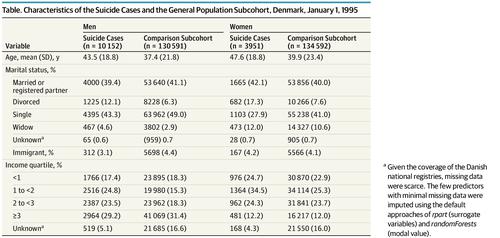当前位置:
X-MOL 学术
›
JAMA Psychiatry
›
论文详情
Our official English website, www.x-mol.net, welcomes your feedback! (Note: you will need to create a separate account there.)
Prediction of Sex-Specific Suicide Risk Using Machine Learning and Single-Payer Health Care Registry Data From Denmark.
JAMA Psychiatry ( IF 25.8 ) Pub Date : 2019-10-23 , DOI: 10.1001/jamapsychiatry.2019.2905 Jaimie L Gradus 1, 2 , Anthony J Rosellini 3 , Erzsébet Horváth-Puhó 2 , Amy E Street 4, 5 , Isaac Galatzer-Levy 6, 7 , Tammy Jiang 1 , Timothy L Lash 2, 8 , Henrik T Sørensen 2
JAMA Psychiatry ( IF 25.8 ) Pub Date : 2019-10-23 , DOI: 10.1001/jamapsychiatry.2019.2905 Jaimie L Gradus 1, 2 , Anthony J Rosellini 3 , Erzsébet Horváth-Puhó 2 , Amy E Street 4, 5 , Isaac Galatzer-Levy 6, 7 , Tammy Jiang 1 , Timothy L Lash 2, 8 , Henrik T Sørensen 2
Affiliation

|
Importance
Suicide is a public health problem, with multiple causes that are poorly understood. The increased focus on combining health care data with machine-learning approaches in psychiatry may help advance the understanding of suicide risk.
Objective
To examine sex-specific risk profiles for death from suicide using machine-learning methods and data from the population of Denmark.
Design, Setting, and Participants
A case-cohort study nested within 8 national Danish health and social registries was conducted from January 1, 1995, through December 31, 2015. The source population was all persons born or residing in Denmark as of January 1, 1995. Data were analyzed from November 5, 2018, through May 13, 2019.
Exposures
Exposures included 1339 variables spanning domains of suicide risk factors.
Main Outcomes and Measures
Death from suicide from the Danish cause of death registry.
Results
A total of 14 103 individuals died by suicide between 1995 and 2015 (10 152 men [72.0%]; mean [SD] age, 43.5 [18.8] years and 3951 women [28.0%]; age, 47.6 [18.8] years). The comparison subcohort was a 5% random sample (n = 265 183) of living individuals in Denmark on January 1, 1995 (130 591 men [49.2%]; age, 37.4 [21.8] years and 134 592 women [50.8%]; age, 39.9 [23.4] years). With use of classification trees and random forests, sex-specific differences were noted in risk for suicide, with physical health more important to men's suicide risk than women's suicide risk. Psychiatric disorders and possibly associated medications were important to suicide risk, with specific results that may increase clarity in the literature. For example, stress disorders among unmarried men older than 30 years were important factors for suicide risk in the presence of depression (risk, 0.54). Generally, diagnoses and medications measured 48 months before suicide were more important indicators of suicide risk than when measured 6 months earlier. Individuals in the top 5% of predicted suicide risk appeared to account for 32.0% of all suicide cases in men and 53.4% of all cases in women.
Conclusions and Relevance
Despite decades of research on suicide risk factors, understanding of suicide remains poor. In this study, the first to date to develop risk profiles for suicide based on data from a full population, apparent consistency with what is known about suicide risk was noted, as well as potentially important, understudied risk factors with evidence of unique suicide risk profiles among specific subpopulations.
中文翻译:

使用来自丹麦的机器学习和单一付款人医疗保健登记数据预测特定性别的自杀风险。
重要性 自杀是一个公共卫生问题,其多种原因尚不清楚。人们越来越关注将医疗保健数据与精神病学中的机器学习方法相结合,这可能有助于增进对自杀风险的理解。目的 使用机器学习方法和丹麦人口的数据来检查自杀死亡的特定性别风险状况。设计、背景和参与者 1995 年 1 月 1 日至 2015 年 12 月 31 日期间,在丹麦 8 个国家卫生和社会登记处进行了一项病例队列研究。来源人群是截至 1 月 1 日在丹麦出生或居住的所有人员。 1995 年。数据分析时间为 2018 年 11 月 5 日至 2019 年 5 月 13 日。暴露 暴露包括涵盖自杀风险因素领域的 1339 个变量。主要成果和措施 丹麦死因登记处的自杀死亡人数。结果 1995 年至 2015 年间,共有 14 103 人死于自杀(10 152 名男性 [72.0%];平均 [SD] 年龄,43.5 [18.8] 岁;3,951 名女性 [28.0%];年龄,47.6 [18.8] 岁) 。比较子队列是 1995 年 1 月 1 日丹麦在世个体的 5% 随机样本 (n = 265 183)(130 591 名男性 [49.2%];年龄 37.4 [21.8] 岁;134 592 名女性 [50.8%];年龄,39.9 [23.4] 岁)。通过使用分类树和随机森林,我们发现自杀风险存在性别差异,身体健康对男性自杀风险的影响比女性自杀风险更重要。精神疾病和可能相关的药物对自杀风险很重要,具体结果可能会增加文献的清晰度。例如,30岁以上未婚男性的压力障碍是抑郁症自杀风险的重要因素(风险,0.54)。一般来说,自杀前 48 个月测量的诊断和药物治疗比 6 个月前测量的诊断和药物治疗更重要。预测自杀风险前 5% 的个体似乎占所有男性自杀病例的 32.0%,占所有女性自杀病例的 53.4%。结论和相关性 尽管对自杀危险因素进行了数十年的研究,但对自杀的了解仍然很少。在这项研究中,迄今为止第一个根据全体人群的数据制定自杀风险概况,注意到与已知的自杀风险明显一致,以及潜在的重要的、未充分研究的风险因素,并有独特的自杀风险概况的证据在特定的亚人群中。
更新日期:2020-01-02
中文翻译:

使用来自丹麦的机器学习和单一付款人医疗保健登记数据预测特定性别的自杀风险。
重要性 自杀是一个公共卫生问题,其多种原因尚不清楚。人们越来越关注将医疗保健数据与精神病学中的机器学习方法相结合,这可能有助于增进对自杀风险的理解。目的 使用机器学习方法和丹麦人口的数据来检查自杀死亡的特定性别风险状况。设计、背景和参与者 1995 年 1 月 1 日至 2015 年 12 月 31 日期间,在丹麦 8 个国家卫生和社会登记处进行了一项病例队列研究。来源人群是截至 1 月 1 日在丹麦出生或居住的所有人员。 1995 年。数据分析时间为 2018 年 11 月 5 日至 2019 年 5 月 13 日。暴露 暴露包括涵盖自杀风险因素领域的 1339 个变量。主要成果和措施 丹麦死因登记处的自杀死亡人数。结果 1995 年至 2015 年间,共有 14 103 人死于自杀(10 152 名男性 [72.0%];平均 [SD] 年龄,43.5 [18.8] 岁;3,951 名女性 [28.0%];年龄,47.6 [18.8] 岁) 。比较子队列是 1995 年 1 月 1 日丹麦在世个体的 5% 随机样本 (n = 265 183)(130 591 名男性 [49.2%];年龄 37.4 [21.8] 岁;134 592 名女性 [50.8%];年龄,39.9 [23.4] 岁)。通过使用分类树和随机森林,我们发现自杀风险存在性别差异,身体健康对男性自杀风险的影响比女性自杀风险更重要。精神疾病和可能相关的药物对自杀风险很重要,具体结果可能会增加文献的清晰度。例如,30岁以上未婚男性的压力障碍是抑郁症自杀风险的重要因素(风险,0.54)。一般来说,自杀前 48 个月测量的诊断和药物治疗比 6 个月前测量的诊断和药物治疗更重要。预测自杀风险前 5% 的个体似乎占所有男性自杀病例的 32.0%,占所有女性自杀病例的 53.4%。结论和相关性 尽管对自杀危险因素进行了数十年的研究,但对自杀的了解仍然很少。在这项研究中,迄今为止第一个根据全体人群的数据制定自杀风险概况,注意到与已知的自杀风险明显一致,以及潜在的重要的、未充分研究的风险因素,并有独特的自杀风险概况的证据在特定的亚人群中。



























 京公网安备 11010802027423号
京公网安备 11010802027423号